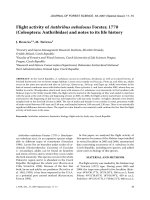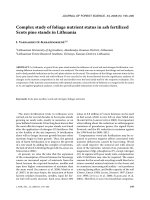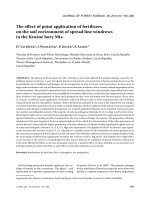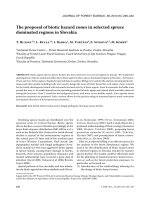Báo cáo lâm nghiệp: "he extent of root rot damage in Norway spruce stands established on fertile sites of former agricultural land" pot
Bạn đang xem bản rút gọn của tài liệu. Xem và tải ngay bản đầy đủ của tài liệu tại đây (168.83 KB, 6 trang )
J. FOR. SCI., 56, 2010 (1): 1–6 1
JOURNAL OF FOREST SCIENCE, 56, 2010 (1): 1–6
Agricultural overproduction in Europe is the main
reason for rising interests in the afforestation of agri-
cultural land. e present EU agricultural policy has
resulted in a new wave of afforestation, which means
that the forestry sector will have to cope with the
specificities of this problem. ere were several waves
of afforestation in history and many high-quality
stands were founded on agricultural land. erefore
we should learn from the present state of these forest
stands to establish stable and productive stands and
especially not to repeat the mistakes of the past.
e quantitative side of timber production is not
usually the problem here, because agricultural land is
usually more productive than forest land. However,
afforestation is different from reforestation in many
aspects, which brings some problems concerning
particularly the stability of some tree species. Most
conifers and especially Norway spruce (Picea abies
[L.] Karst.) are endangered on former agricultural
land by primary parasitic wood-damaging fungi
– Heterobasidion annosum (Fr.) Bref. and Armil-
laria ostoyae (Romagn.) Herink. It is a well-known
fact that Norway spruce stands established on
abandoned agricultural land after World War II are
today heavily damaged by the red rot of Heteroba-
sidion annosum and their stability is rather poor. e
danger of upcoming climate change is also expected
to increase the damage caused by Heterobasidion
annosum, especially at water-affected and former
agricultural sites (J 2002).
e site history is a very important factor deter-
mining the intensity of Heterobasidion annosum
infection. In order to understand the behaviour of
the fungus at a given site it would be important to
know the earlier stand composition, the former use
as a pasture or arable land, and the thinning and
felling regimes used, as well as other management
practices carried out in the stand (K,
S 1998).
Damage caused by Heterobasidion annosum is
usually greater on land formerly used for agriculture
than on old forest soils. e disease usually starts
after the first thinnings. e risk is especially high
in fields with high lime content and pH > 6, which
is partially due to the low amounts of antagonistic
Trichoderma and Penicillinum species in agricultural
e extent of root rot damage in Norway spruce stands
established on fertile sites of former agricultural land
R. M
Faculty of Forestry and Wood Technology, Mendel University in Brno,
Brno, Czech Republic
ABSTRACT: e aim of this study was to compare the degree of root rot damage in two large complexes of Norway
spruce stands established on former agricultural land at fertile sites. e root rot infection was observed on the stump
cutting area on both intended and salvage clear fellings. Stands in Kružberk area in the Nízký Jeseník Mts. established
on arable land showed very poor stability and large root rot damage at the age of 40–50 years. In contrast, stands in
Lužná area in the Javorníky Mts., founded on former sheep pastures, were markedly much less damaged at the age of
90–110 years and proved to be able to provide quality timber, although they were damaged by the root rot as well.
Keywords: afforestation of agricultural land; Kružberk area; Lužná area; Norway spruce; root rot
Supported by the Ministry of Education, Youth and Sports of the Czech Republic, Project No. MSM 6215648902.
2 J. FOR. SCI., 56, 2010 (1): 1–6
soils in general and alkaline soils in particular. An-
other factor favouring the disease is the development
of superficial root systems due to subsoil compac-
tion, which increases the number of root contacts
and helps the vegetative spread of the fungus from
tree to tree (K, S 1998).
Problems with water supply are often mentioned
as one of the main reasons for severe root rot dam-
age in Norway spruce stands. e superficial root
system on former agricultural land suffers from wa-
ter deficiency in dry periods and therefore the con-
centration of fungistatic substances in the phloem
decreases, which along with the turgor decrease
makes the trees more prone to the fungal infection
(Č 1989).
MATERIAL AND METHODS
e aim of this study was to compare the degree of
root rot damage in two large complexes of Norway
spruce stands established on former agricultural
land at fertile sites in two upland regions of Moravia.
e basic idea was to find differences in the health
condition between stands of these two areas, which
had the same species composition (pure spruce) and
the same or comparable typological units (group of
forest types), whereas both complexes were proved
to be the first generation of forest on former agri-
cultural land.
e first complex (Kružberk area) is situated in the
Nízký Jeseník Mts. west of the Kružberk dam on the
Moravice River. e stands of today’s 3
rd
to 5
th
age
classes were founded in abandoned fields at an alti-
tude of 460–620 m a.s.l. after the German population
of the village of Herzogwald had been expelled after
World War II (M 2005).
e second complex (Lužná area) is situated in
the Javorníky Mts. northeast of the village of Lužná.
ese stands were founded on former sheep pastures
about a hundred years ago when the need for qual-
ity spruce timber had emerged in this region. ese
stands lie on a steep southern slope at an altitude
of 550–730 m a.s.l. Military maps from the 18
th
and
19
th
century were used to verify that these stands
were really the first generation of forest on former
pastures. e first local afforestation activities date
back to the last quarter of the 19
th
century. e old-
est stands from the first afforestation period, which
started in 1875, have already been mostly cut down
and reforested. e present study is aimed at spruce
stands from the second wave of afforestation, which
was conducted after 1896 (Ž 1984).
e main problem concerning the detection of
root rot damage on living trees of younger age is that
the symptoms are not always apparent. Symptoms
of Heterobasidion annosum root rot in living trees
are not characteristic and cannot be distinguished
from those caused by other root diseases. In spruce,
extensive butt rot can develop within the stem of a
living tree, without any external symptoms (G
1998).
e degree of fungal attack was therefore analyzed
on the surface of stumps on clear-cut areas. e
clear cuts were both planned final cuts (Lužná area)
and salvage cuttings and planned reconstruction
clear cuttings (Kružberk area). e particular spe-
cies of fungi were not identified within this study.
e own five-class scale (Table 1) was used to assess
the degree of rot damage to each single stump on a
clear-cut area. e percentage of these classes was
calculated for each plot. e survey was made by
one person, so the subjectivity of such an assessment
allows to compare single plots among themselves
and both complexes of the studied forests with each
other.
In Kružberk area seven plots were assessed in
total. ere were two plots set in the large stand
412C5 (Forest Management Plan as of 1. 1. 2003) to
compare different terrain orientation of two separate
clear-cuts – plot K3a was on a hill top and plot K3b
was on its northern side, but both plots were still in
quite a plain terrain.
In some stands almost all trees were damaged by
deer barking, but there were some stands (412C5
and 401B5, i.e. plots K3a, K3b and K5) near the vil-
lage of Dvorce where there was not any kind of such
damage. is made it possible to compare the rot
damage in stands with and without the influence of
deer barking and later the infection by secondary
parasitic fungi. e cause of salvage fellings was a
windthrow in most cases and also bark beetles in
small plots. ese spots were usually extended into
Table 1. Classification of stumps according to the degree
of root rot damage
Class Extent of rot damage
1
healthy, no signs of fungal attack on the stump
cutting area
2
small area of hard rot up to 10% of stump area,
marginal soft rot up to 5%
3
large hard rot, small soft rot area, between classes
2 and 4
4 large soft rot above 30%
5 whole stump area rotten or a large central hollow
J. FOR. SCI., 56, 2010 (1): 1–6 3
a larger reconstruction harvest and the survey was
carried out on the whole clear-cut areas.
In Lužná area (Forest Management Plan as of
1. 1. 2000) ten sample plots were assessed, which
were all intended final fellings. Two clear-cut areas
(in stands 2h9 and 2o10) were divided after a re-
connaissance into two sample plots because of two
reasons. e clear-cut area in stand 2h9 was divided
in the map of forest site types into two parts with
different altitudinal vegetation zones (forest types
4B1 and 5B1), so it was decided to set two separate
sample plots there according to this border to find
out if there is any difference in root rot damage.
e clear cut in stand 2o10 was divided into two
sample plots (L6a and L6b), because its large part
was situated on a small and rather elevated stony
ridge with apparently different site conditions from
the rest of the clear-cut area, although this was not
differentiated in the type map.
Chi-square statistic (programme Unistat version
5.1) was used to compare the distribution of rot
classes and to detect the frequency dependence
among individual plots within both areas (Lužná
and Kružberk) to see if there is a statistical differ-
ence. is was also done to compare the plots in
stands with and without the deer barking damage
in Kružberk area.
RESULTS AND DISCUSSION
All plots in Kružberk area (Table 2) showed great
root rot damage. e most surprising fact is that the
plots in stands without any signs of old deer barking
damage (K3a, K3b, K5) had worse results compared
to stands greatly damaged by game and secondary
fungal infection. e difference is, however, only in
the degree of rot on the stumps, as nearly all stumps in
the whole Kružberk area showed signs of rot infection.
Stands without the deer barking damage lie very close
to the village of Dvorce, where the intensity of former
soil cultivation and fertilizing is expected to have been
quite high. is only proves the fact that on fertilized
arable land the red rot of Heterobasidion annosum is
a real threat to Norway spruce disregarding additional
damage to stems caused by game. e least rot dam-
age within Kružberk area was found on plot K2 with
some healthy stumps. Also the forest type (5S1) is
different there from the other stands, which suggests
that the stands at less fertile sites are more resistant to
rot. No significant difference was found between two
plots (K3a, K3b) in stand 412C5 (Table 4).
e fact that the plots in Kružberk area were set
on salvage cuttings may have slightly influenced the
objectivity of obtained results for the whole area, but
there were no indications that the root rot damage to
surrounding and still standing trees could have been
significantly lower.
Spruce stands established on former sheep pas-
tures in Lužná area about a hundred years ago have
a much better health condition from the aspect of
root rot damage (Table 3). Summary percentages
of classes 1 and 2 exceed 50% in all but one (L6b)
sample plot. Plot L6b was situated on a small stony
ridge within the main slope. e other part of the
clear cut (plot L6b) showed significantly better
results. Analogous results were found on plots L5a
and L5b, which are two adjacent clear cuts. e
visibly drier conditions and more exposed terrain
on L5b have apparently resulted in the greater root
rot damage.
Table 2. e Kružberk area results. Number of stumps in each class and respective percentages
Plot No. K1 K2 K3a K3b K4 K5 K6
Stand No. 303E5 303B5 412C5 412C5 402E5 401B5 303A5
Forest type 5B1 5S1 5B3 5B3 5B1 5B3 5B1
Age 42 49 47 47 42 47 42
n (%) n (%) n (%) n (%) n (%) n (%) n (%)
Class
Total
1 0 0.00 12 17.65 4 2.80 2 1.79 2 1.59 4 4.44 2 2.41
2 3 5.45 10 14.71 10 6.99 10 8.93 14 11.11 4 4.44 12 14.46
3 15 27.27 16 23.53 15 10.49 17 15.18 30 23.81 15 16.67 26 31.33
4 17 30.91 15 22.06 43 30.07 36 32.14 39 30.95 31 34.44 25 30.12
5 20 36.36 15 22.06 71 49.65 47 41.96 41 32.54 36 40.00 18 21.69
55 100 68 100 143 100 112 100 126 100 90 100 83 100
4 J. FOR. SCI., 56, 2010 (1): 1–6
e results from stand 2h9, where the clear-cut
area was divided into two plots (L2a and L2b) ac-
cording to the border (contour line) of altitudinal
vegetation zones, did not show any significant dif-
ferences (Table 5) as both the lower and the upper
half of the clear cut had very similar frequency of
rot classes.
e best health condition of spruce was found on
plot L7 in the easternmost part of Lužná area. is
plot had the highest altitude (730 m) in this study.
Table 4. Statistical comparison of plots in Kužberk area by means of chi-square statistic, with the marking of significance.
Calculated values of chi-square
Kružberk K1 K2 K3a K3b K4 K5
K6 6.6 11.10* 26.0** 12.96* 3.8 14**
K5 4.6 18.10** 4.1 2.80 6.6
K4 4.7 19.20** 13.5** 3.98
K3b 4.7 22.95** 2.6
K3a 10.6* 31.30**
K2 15.4**
*Statistically significant difference, **Statistically highly significant difference
Table 3. e Lužná area results. Number of stumps in each class and respective percentages
Plot No. L1 L2a L2b L3 L4
Stand No. 2l10 2h9 2h9 2l10 2m10
Forest type 5B1 4B1 5B1 5A3 5U1,5B1
Age 99 91 91 98 103
n (%) n (%) n (%) n (%) n (%)
Class
Total
1 47 25.82 36 21.69 23 20.00 31 14.49 37 25.34
2 67 36.81 49 29.52 35 30.43 84 39.25 50 34.25
3 35 19.23 33 19.88 22 19.13 44 20.56 28 19.18
4 18 9.89 20 12.05 17 14.78 33 15.42 16 10.96
5 15 8.24 28 16.87 18 15.65 22 10.28 15 10.27
182 100 166 100 143 100 112 100 126 100
Plot No. L5a L5b L6a L6b L7
Stand No. 2p11 2r11 2o10 2o10 8a11
Forest type 4B1 5B1 5B1 5B1 5B2
Age 107 100 100 100 107
n (%) n (%) n (%) n (%) n (%)
Class
Total
1 21 22.34 14 16.87 37 21.76 14 11.11 63 43.15
2 42 44.68 32 38.55 65 38.24 32 25.40 46 31.51
3 23 24.47 19 22.89 36 21.18 34 26.98 14 9.59
4 8 8.51 8 9.64 22 12.94 31 24.60 14 9.59
5 0 0.00 10 12.05 10 5.88 15 11.90 9 6.16
94 100 83 100 143 100 112 100 126 100
J. FOR. SCI., 56, 2010 (1): 1–6 5
It may be the influence of better climate conditions
for Norway spruce there, when almost a half of the
stumps were healthy even at the age of 107 years.
CONCLUSIONS
The results from Kružberk have proved that
Norway spruce stands established there on arable
land are totally damaged by the red root rot of He-
terobasidion annosum at the age of 40–50 years and
therefore they cannot provide quality timber even
at the half time of their intended period. Almost all
trees in this area were infected on a stump cutting
area by root rot regardless of previous damage to
stems caused by game. e extent of root rot was
even greater in two stands without deer barking
damage, in the vicinity of the village of Dvorce. e
least extent of root rot infection was observed in the
stand at a rather less fertile site.
The results from Lužná area show that spruce
stands founded there on former sheep pastures are
relatively stable even at the end of their intended
rotation period and can provide timber assortments
of high quality, although they were largely infected by
the root rot as well. e root rot damage, however,
corresponds to the age of these stands at nutrient
rich sites. If the rotation period of these stands were
shorter there, the extent of root rot infection would
be even smaller. Significantly higher root rot damage
in the Lužná area was found at exposed stony places
with the signs of old soil erosion.
e target tree species composition is today de-
termined according to the forest type classification
of afforested land. But the starting site conditions of
agricultural land are usually very different from the
(potential) conditions of forest environment. is
causes many problems for the cultivation of stable
and quality forest stands even if the site classification
is made correctly.
e recommendation for today’s afforestation of
agricultural land is therefore to avoid establishing
pure Norway spruce stands on arable land as there is
no chance that most of them can survive until their
usual rotation age. Spruce can be planted there as
an admixture to ensure the fast restoration of forest
soil characteristics and to provide high timber vol-
umes from thinnings. On the other hand, Norway
spruce as our main commercial tree species can
be used at a certain proportion even in unmixed
stands on former pastures and other mountain
grasslands with suitable soil and climate conditions.
e reasonably shortened rotation period at these
sites would reduce the root rot damage to a more
acceptable level.
R ef e re nce s
Č A. (1989): Parasitic Wood-damaging Fungi. Prague,
SZN: 104 .
G B.J.W. (1998): Field Recognition and Diagnosis of Het-
erobasidion annosum. In: W S. et al. (eds): Hetero-
basidion annosum: Biology, Ecology, Impact and Control.
Cambridge, CAB International International: 35–41.
J L. (2002): e enhanced risk of tree species dis-
eases in the conditions of climatic change. Lesnická práce,
81: 206–208
K K., S J. (1998): Biology of Hererobasidion
annosum. In: W S. et al. (eds): Heterobasidion an-
nosum: Biology, Ecology, Impact and Control. Cambridge,
Table 5. Statistical comparison of plots in Lužná area by means of chi-square statistic, with the marking of significance.
Calculated values of chi-square
Lužná L1 L2a L2b L3 L4 L5a L5b L6a L6b
L7 13.40** 24.80** 21.80** 39.2** 13.2* 23.9** 20.3** 19.8** 48.7**
L6b 24.30** 14.40** 8.80 10.3* 18.3** 29.4** 10.4* 18.0**
L6a 2.20 10.97* 8.30 5.5 3.1 7.5 3.9
L5b 3.30 3.40 2.97 2.0 2.6 12.5*
L5a 9.96* 21.10** 20.10** 15.3** 12.6*
L4 0.60 3.50 3.30 7.4
L3 9.40 9.10 4.90
L2b 6.80 0.60
L2a 7.60
*Statistically significant difference, **Statistically highly significant difference
6 J. FOR. SCI., 56, 2010 (1): 1–6
CAB International: 43–70.
M R. (2005): Root rot damage in the Norway spruce
stands fouded on former agricultural land. In: Š P.
(ed.): Proceedings of International Postgraduate Students’
Conference MendelNet 2005 – Contemporary State and
Development Trends of Forest in Cultural Landscape.
Corresponding author:
Ing. R M, Mendelova univerzita v Brně, Lesnická a dřevařská fakulta, Zemědělská 3, 613 00 Brno,
Česká republika
tel.: + 420 777 318 665, e-mail:
Brno, MZLU: 61–65.
Ž V. (1984): e History of Forests. Frýdek-Místek,
Lesprojekt.
Received for publication March 26, 2009
Accepted after corrections June 2, 2009









